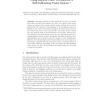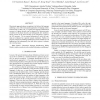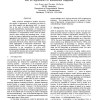256 search results - page 25 / 52 » How iris recognition works |
IJCNN
2008
IEEE
14 years 4 months ago
2008
IEEE
—A novel wake-sleep learning architecture for processing a robot’s facial expressions is introduced. According to neuroscience evidence, associative learning of emotional respo...
ROBOCUP
2004
Springer
14 years 3 months ago
2004
Springer
This paper presents a vision system for robotic soccer which was tested on Sony’s four legged robot Aibo. The input for the vision system are images of the camera and the sensor ...
ACL
2003
13 years 11 months ago
2003
Discourse chunking is a simple way to segment dialogues according to how dialogue participants raise topics and negotiate them. This paper explains a method for arranging dialogue...
ICASSP
2010
IEEE
13 years 10 months ago
2010
IEEE
Phonotactic approach, phone recognition to be followed by language modeling, is one of the most popular approaches to language identification (LID). In this work, we explore how ...
IJCAI
1989
13 years 11 months ago
1989
Many artificial intelligence systems implicitly use notions of granularity in reasoning, but there is very little research into granularity itself. An exception is the work of Hob...



